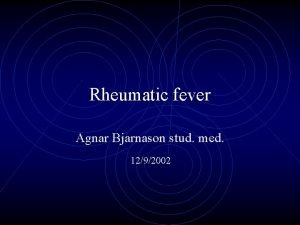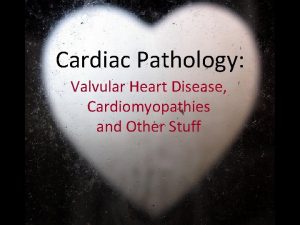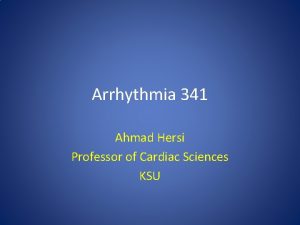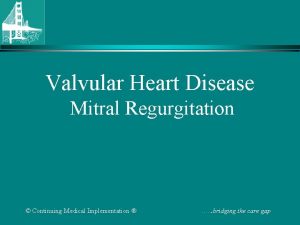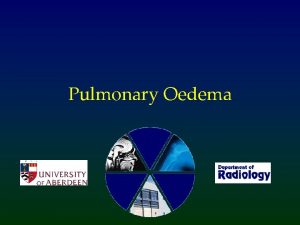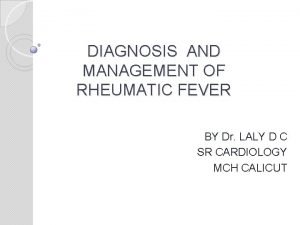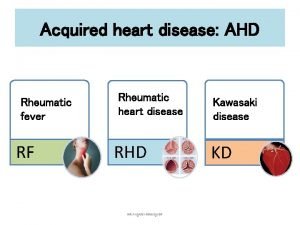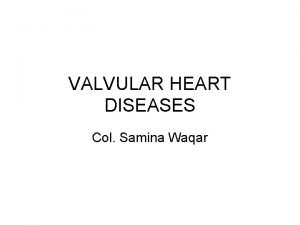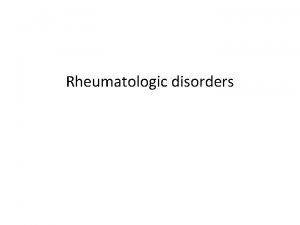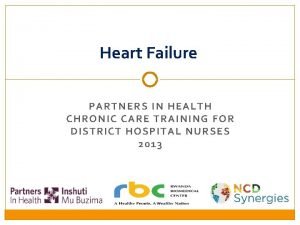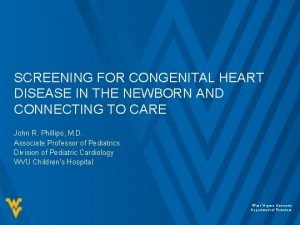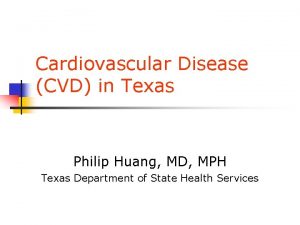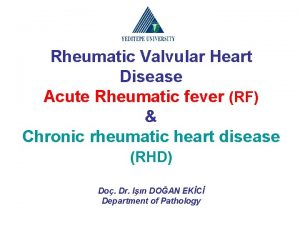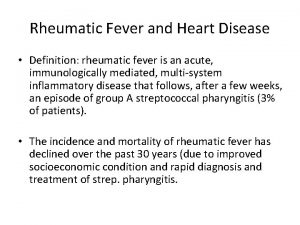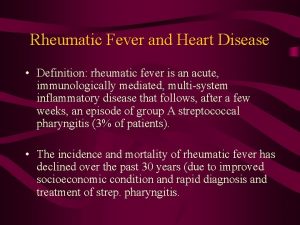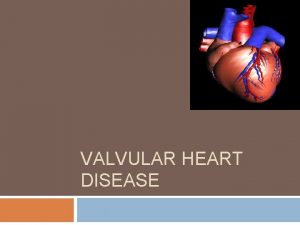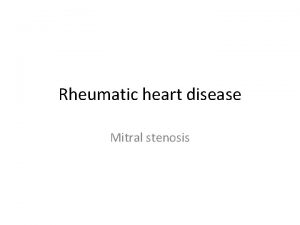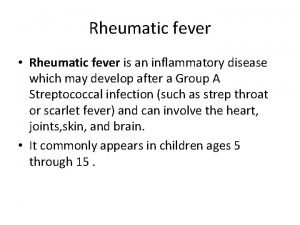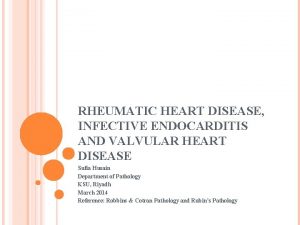Valvular heart disease Acute rheumatic fever Rheumatic fever























- Slides: 23

Valvular heart disease Acute rheumatic fever

Rheumatic fever • It typically occurs several weeks after streptococcal pharyngitis. • The most common pathogen is group A beta-hemolytic streptococci (GABHS) • Streptococcus cross-react with proteins in cardiac valves. • Time from acute streptococcal infection to onset of symptomatic rheumatic fever (RF) is usually 3– 4 weeks. • RF is thought to complicate up to 3% of untreated streptococcal sore throats. • Previous episodes of RF predispose to recurrences.

Diagnostic criteria for rheumatic fever (Jones criteria) • Evidence of group A streptococcal pharyngitis • Either a positive throat culture or rapid streptococcal antigen test, or an elevated or rising streptococcal antibody titer (samples taken 2 weeks apart). • Plus two major or one major and two minor Jones criteria: Major criteria • Polyarthritis • Carditis • Chorea • Erythema marginatum • Subcutaneous nodules Minor criteria • Fever • Arthralgia • Prolonged PR interval • Elevated ESR and CRP

Joints • Migratory large-joint polyarthritis starting in the lower limbs in 75% of cases. Duration is <4 weeks at each site. There is severe pain and tenderness in contrast to a mild degree of joint swelling.

Heart • Pancarditis occurs in 50% of cases with features of acute heart failure, mitral and aortic regurgitation, and pericarditis. • Endocarditis • affects the mitral valve (65%– 70%), aortic valve (25%), and tricuspid valve (10%, never in isolation), causing acute regurgitation and heart failure but chronic stenosis. • Pericarditis • Pain • Friction rub • rarely causes hemodynamic instability/tamponade or constriction.

Heart Myocarditis • Acute heart failure • Arrhythmias • Most common reason of death

Skin • Erythema marginatum is an evanescent rash with serpiginous outlines and central clearings on the trunk and proximal limbs. • seen in 5%– 13% of cases. • It begins as erythematous, nonpruritic papules or macules that spread outward. It fades and reappears in hours and persists throughout the disease course.

Skin • Subcutaneous nodules are seen in 0– 8% of cases usually several weeks after the onset of pancarditis. • Collagen lumps • They occur mainly over bony surfaces or joint prominences and tendons and usually last 1 – 2 weeks.

CNS • Chorea occurs in 10%– 30%, usually occurs 1– 6 months after pharyngitis. Patients exhibit difficulties in writing and speaking, generalized weakness, choreiform movements, and emotional lability. Joints are hyperextended with hypotonia, diminished tendon reflexes, tongue fasciculation, and a relapsing grip (alternate increases and decreases in tension). Full recovery is usually in 2– 3 months.

Inflamation • Sore throat occurs 1– 5 weeks prior in twothirds of cases. • Fever, abdominal pain, and epistaxis.

Acute Rheumatic Fever PREVENTION • ↓Strep infections • Antibiotics Chronic Rheumatic Heart Disease

FIBROSIS of the VALVES Stenosis Regurgitation

Mitral stenosis. COMPLAINS • The most common etiology is rheumatic heart disease. • Dyspnea on exertion, orthopnea, paroxysmal nocturnal dyspnea. • Acute pulmonary edema may be precipitated by uncontrolled AF, exercise, pulmonary infection, anesthesia, and pregnancy. • Fatigue is due to reduced cardiac output reserve.

Mitral stenosis. COMPLAINS • Hemoptysis can occur for a variety of reasons: alveolar capillary rupture (pink frothy pulmonary edema); bronchial vein rupture (larger hemorrhage); blood-stained sputum of chronic bronchitis; pulmonary infarction (low CO, immobile patient). • Chest pain similar to angina may occur in patients with pulmonary hypertension and RV hypertrophy, even with normal coronaries. • The enlarging LA may compress surrounding structures, producing hoarse voice (left recurrent laryngeal nerve compression— Ortner’s syndrome), dysphagia (esophageal compression), and left lung collapse (left main bronchus compression).

Classification Severity of Mitral Stenosis, by Valve Area, Gradient, and Pulmonary Pressure Severity Valve Area, cm 2 Mean Gradient, mm Hg Systolic Pulmonary artery pressure. (PAP), mm Hg Mild >1. 5 <6 Normal Moderate ≤ 1. 5 6– 11 ≤ 50 Severe <1 ≥ 12 >50

Mitral stenosis. Physical exam findings • Mitral facies or malar flush • Small-volume arterial pulse • Irregularly irregular pulse in AF • “Tapping” apex beat—palpable S 1 • Diastolic thrill at apex

Mitral stenosis. Auscultation • S 1 is loud if in sinus rhythm • P 2 is accentuated. Opening snap (OS) of the MV is heard best at or medial to the apex in expiration. • The A 2–OS interval varies inversely with severity of stenosis. • Low-pitched, rumbling, mid-diastolic murmur with presystolic accentuation (if in sinus rhythm) is heard best at the apex with patient in left lateral position. • Early diastolic murmur due to pulmonary regurgitation from pulmonary hypertension (Graham–Steell murmur) may be heard.

Mitral stenosis. Treatment • Percutaneous mitral balloon valvotomy (PMBV) • Moderate to severe symptoms or development of pulmonary hypertension (>50 mm. Hg at rest or >60 mm. Hg with exercise) warrants mechanical relief of mitral valve obstruction, and PMBV is the preferred approach to achieve this. In PMBV, a guide wire is placed in LA after trans-septal puncture and a balloon (Inoue balloon) is directed across the valve and inflated at the orifice. • This procedure is suitable for patients with pliable valves with minimal MR, no subvalvular distortion, and without heavy calcification. An ECHO-derived Wilkins score <8 predicts procedural success and should be determined in each case. • Surgical • Closed valvotomy. Fused cusps separated by a dilator introduced through LV apex. Results are inferior to PMBV so it is now rarely performed. • Open valvotomy with cardiopulmonary bypass is preferred to closed valvotomy. Cusps are separated under direct vision. Any fusion of subvalvular apparatus is loosened. • Mitral valve replacement is used if there is significant MR or the valve is severely diseased or heavily calcified.

Mitral regurgitation. Causes • Acute • Infective endocarditis • Acute myocardial infarction (MI) (usually inferior wall) from papillary muscle dysfunction or acute rupture • Trauma • Chronic • Mitral valve prolapse • Rheumatic heart disease • Ischemic heart disease • Left ventricular dilatation of any cause • Hypertrophic cardiomyopathy • Carcinoid syndrome

Mitral regurgitation. Complains • acute severe MR: • pulmonary edema is common. • chronic MR, • fatigue, • exertional dyspnea, orthopnea, • palpitations are due to premature atrial beats or AF. • symptoms of pulmonary hypertension/RV failure occur in later stages.

Mitral regurgitation. Physical exam findings • Rapid upstroke in arterial pulse • Forceful AI (apex impulse) displaced laterally. • Diffuse and hyperdynamic AI, which may be visible • Systolic thrill at apex

Mitral regurgitation. Auscultation • Soft first heart sound • Wide splitting of S 2 due to premature aortic valve closure • Prominent low-pitched S 3 • Pansystolic murmur loudest at the apex and radiating into the axilla • A mid-diastolic flow murmur may follow S 3.

Mitral regurgitation. Treatment mitral valve repair or replacement • Asymptomatic patients with a normal or hyperdynamic ejection fraction can continue to have regular observation.
 Acute rheumatic fever
Acute rheumatic fever Pathophysiology of valvular heart disease
Pathophysiology of valvular heart disease Dopamine uses
Dopamine uses Causes of valvular heart disease
Causes of valvular heart disease Mitral regurgitation symptoms
Mitral regurgitation symptoms Pathophysiology of valvular heart disease
Pathophysiology of valvular heart disease Site:slidetodoc.com
Site:slidetodoc.com Site:slidetodoc.com
Site:slidetodoc.com Right sided heart failure
Right sided heart failure Upper lobe diversion
Upper lobe diversion Vijaya's echo criteria
Vijaya's echo criteria Ahd heart
Ahd heart Rheumatic heart disease
Rheumatic heart disease Rheumatic heart disease causes
Rheumatic heart disease causes Ie
Ie Brain soap md
Brain soap md Traslape valvular
Traslape valvular An acute highly contagious viral disease
An acute highly contagious viral disease Roman fever edith wharton summary
Roman fever edith wharton summary Acute vs chronic heart failure
Acute vs chronic heart failure Communicable disease and non communicable disease
Communicable disease and non communicable disease Nyha classifications
Nyha classifications Farah garmany
Farah garmany Heart disease data
Heart disease data
